Page 1036 of 1070
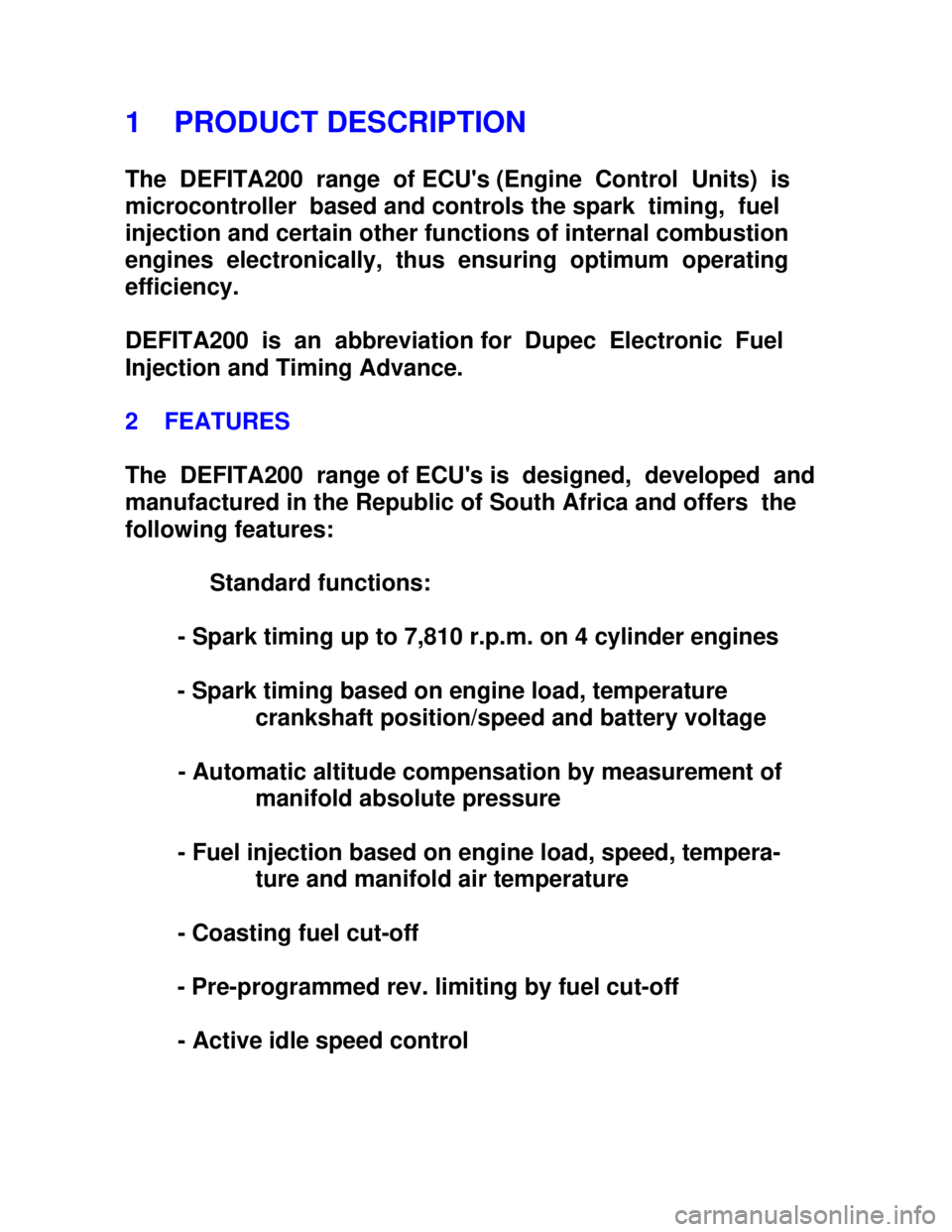
Downloaded from www.Manualslib.com manuals search engine 1 PRODUCT DESCRIPTION
The DEFITA200 range of ECU's (Engine Control Units) is
microcontroller based and controls the spark timing, fuel
injection and certain other functions of internal combustion
engines electronically, thus ensuring optimum operating
efficiency.
DEFITA200 is an abbreviation for Dupec Electronic Fuel
Injection and Timing Advance.
2 FEATURES
The DEFITA200 range of ECU's is designed, developed and
manufactured in the Republic of South Africa and offers the
following features:
Standard functions:
- Spark timing up to 7,810 r.p.m. on 4 cylinder engines
- Spark timing based on engine load, temperature
crankshaft position/speed and battery voltage
- Automatic altitude compensation by measurement of
manifold absolute pressure
- Fuel injection based on engine load, speed, tempera-
ture and manifold air temperature
- Coasting fuel cut-off
- Pre-programmed rev. limiting by fuel cut-off
- Active idle speed control
Page 1039 of 1070
Downloaded from www.Manualslib.com manuals search engine 4 SPECIFICATION
The following specification is applicable to DEFITA200 P/N:
A020-C ECU's unless otherwise stated:
4.1 Electrical
Operating voltage : 9 to 15 VDC continuous : 6 to 16 VDC limited functions : 24 VDC for 60 seconds maximum
Operating current : Less than 500 mA
Standby current : Less than 12 mA (>1 minute after
ignition off)
Timing accuracy : +/- 0.5 degrees
R.p.m. limit : 6,297
Reference signal : Negative edge from Distributor Y24
at 10ø BTDC
Base timing : 10ø BTDC r.p.m. < 450 or diagnostics initia- lised after starting
Mapped timing : r.p.m. > 450 and diagnostics dis-
abled
Selectable octane maps : 97 RON Factory fitted
: 93 RON
: 87 RON
: 87D RON (For fuel with octane
below 87 RON)
Selectable by interchanging octane plug on harness
Page 1044 of 1070
Downloaded from www.Manualslib.com manuals search engine 6 SPARK TIMING
Spark timing and fuel injection for DEFITA200 ECU's is
calculated by a central processing unit and are based on:
I - MAP
II - EWT
III - Battery voltage
IV - Crankshaft position
V - Engine speed
VI - Throttle position
The optimum timing advance curves for a given engine are
determined by running the engine on an engine dynamometer
under any combination of the above-mentioned conditions.
This process is known as mapping the engine. The mapping is
further refined by extensive driving tests.
The mapped data regarding the engine is stored in a ROM
(Read Only Memory) within the ECU.
The following processes take place when calculating the
advance angle:
I - engine speed and crankshaft position measurement
II - engine load measurement
III - advance angle look-up
IV - ignition firing delay calculation
Page 1045 of 1070
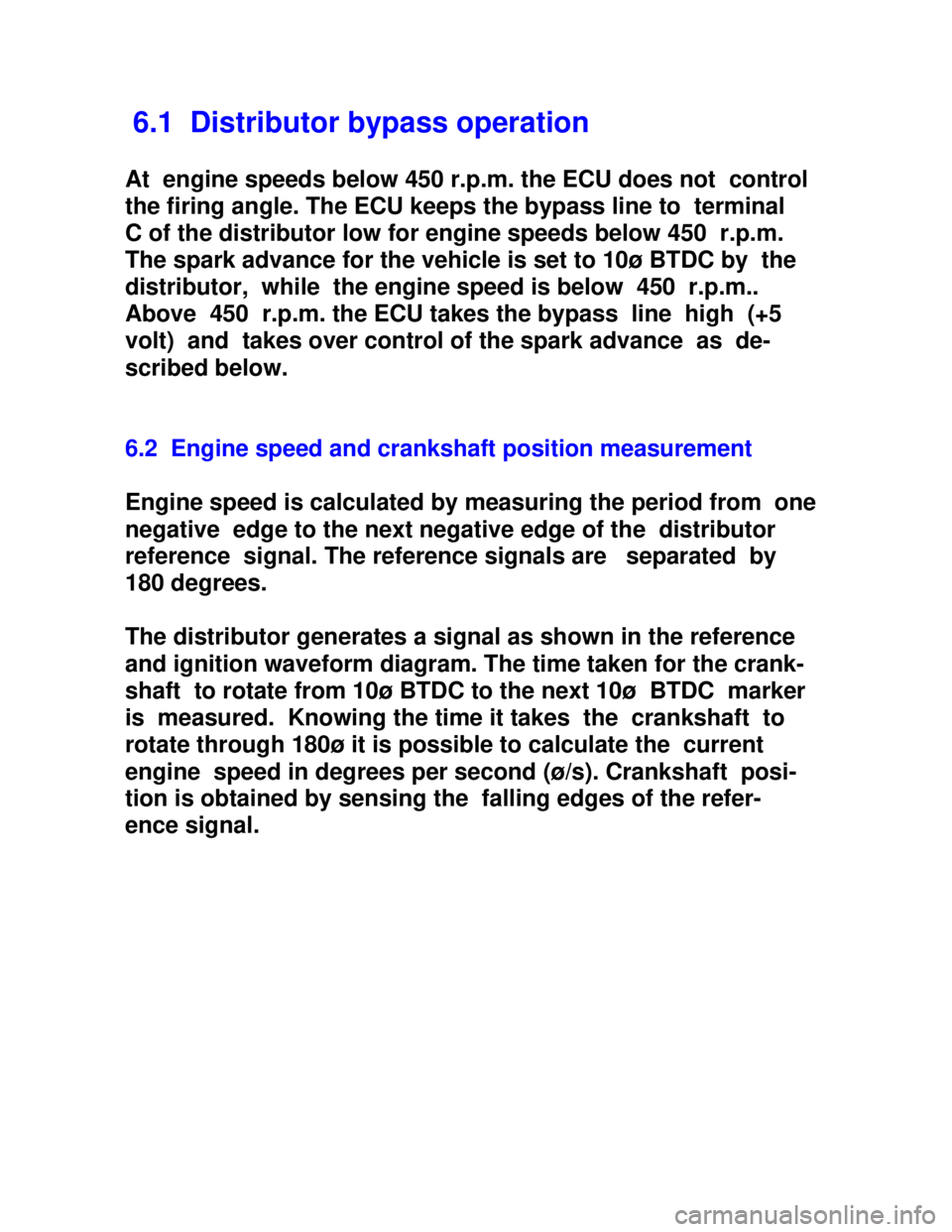
Downloaded from www.Manualslib.com manuals search engine 6.1 Distributor bypass operation
At engine speeds below 450 r.p.m. the ECU does not control
the firing angle. The ECU keeps the bypass line to terminal
C of the distributor low for engine speeds below 450 r.p.m.
The spark advance for the vehicle is set to 10ø BTDC by the
distributor, while the engine speed is below 450 r.p.m..
Above 450 r.p.m. the ECU takes the bypass line high (+5
volt) and takes over control of the spark advance as de-
scribed below.
6.2 Engine speed and crankshaft position measurement
Engine speed is calculated by measuring the period from one
negative edge to the next negative edge of the distributor
reference signal. The reference signals are separated by
180 degrees.
The distributor generates a signal as shown in the reference
and ignition waveform diagram. The time taken for the crank-
shaft to rotate from 10ø BTDC to the next 10ø BTDC marker
is measured. Knowing the time it takes the crankshaft to
rotate through 180ø it is possible to calculate the current
engine speed in degrees per second (ø/s). Crankshaft posi-
tion is obtained by sensing the falling edges of the refer-
ence signal.
Page 1049 of 1070
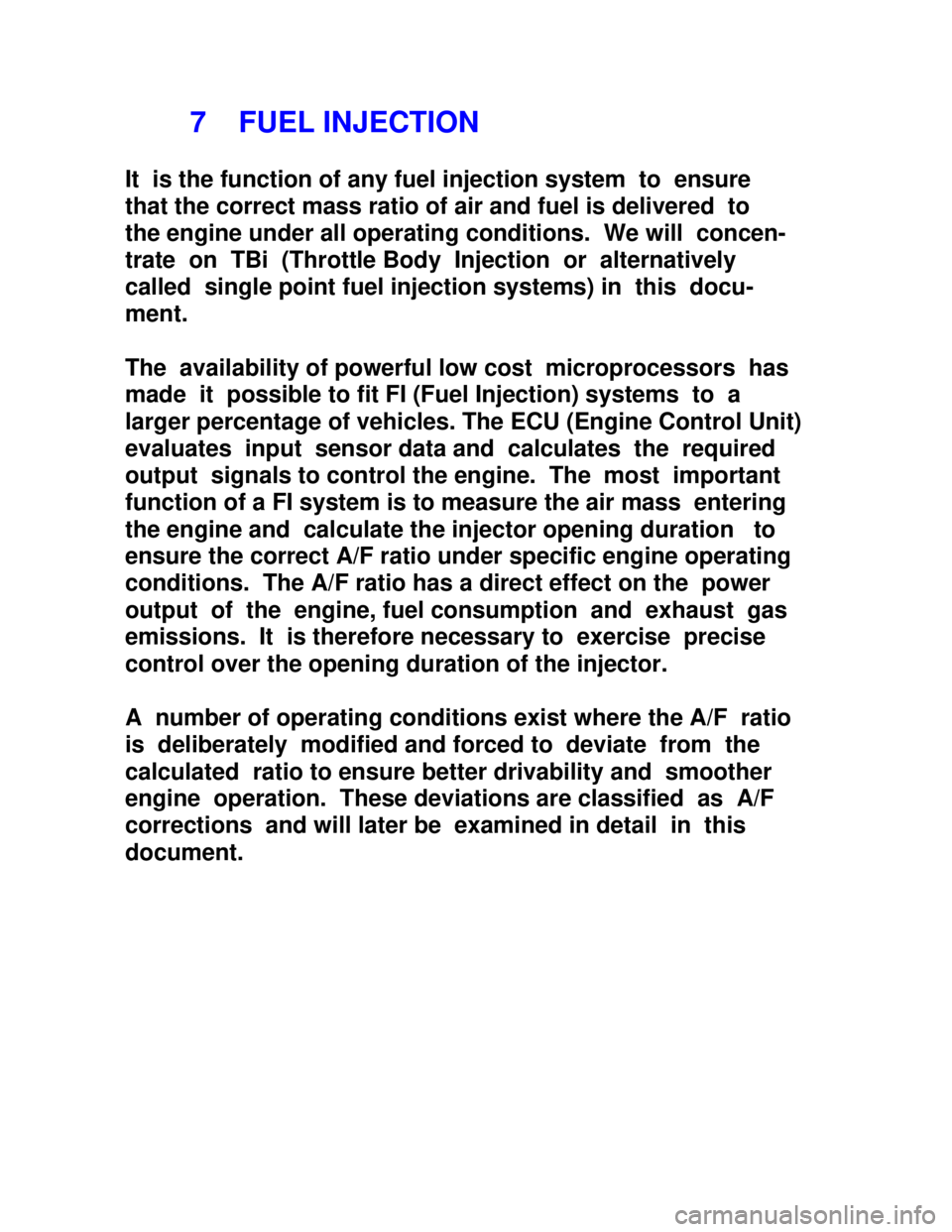
Downloaded from www.Manualslib.com manuals search engine 7 FUEL INJECTION
It is the function of any fuel injection system to ensure
that the correct mass ratio of air and fuel is delivered to
the engine under all operating conditions. We will concen-
trate on TBi (Throttle Body Injection or alternatively
called single point fuel injection systems) in this docu-
ment.
The availability of powerful low cost microprocessors has
made it possible to fit FI (Fuel Injection) systems to a
larger percentage of vehicles. The ECU (Engine Control Unit)
evaluates input sensor data and calculates the required
output signals to control the engine. The most important
function of a FI system is to measure the air mass entering
the engine and calculate the injector opening duration to
ensure the correct A/F ratio under specific engine operating
conditions. The A/F ratio has a direct effect on the power
output of the engine, fuel consumption and exhaust gas
emissions. It is therefore necessary to exercise precise
control over the opening duration of the injector.
A number of operating conditions exist where the A/F ratio
is deliberately modified and forced to deviate from the
calculated ratio to ensure better drivability and smoother
engine operation. These deviations are classified as A/F
corrections and will later be examined in detail in this
document.
Page 1054 of 1070
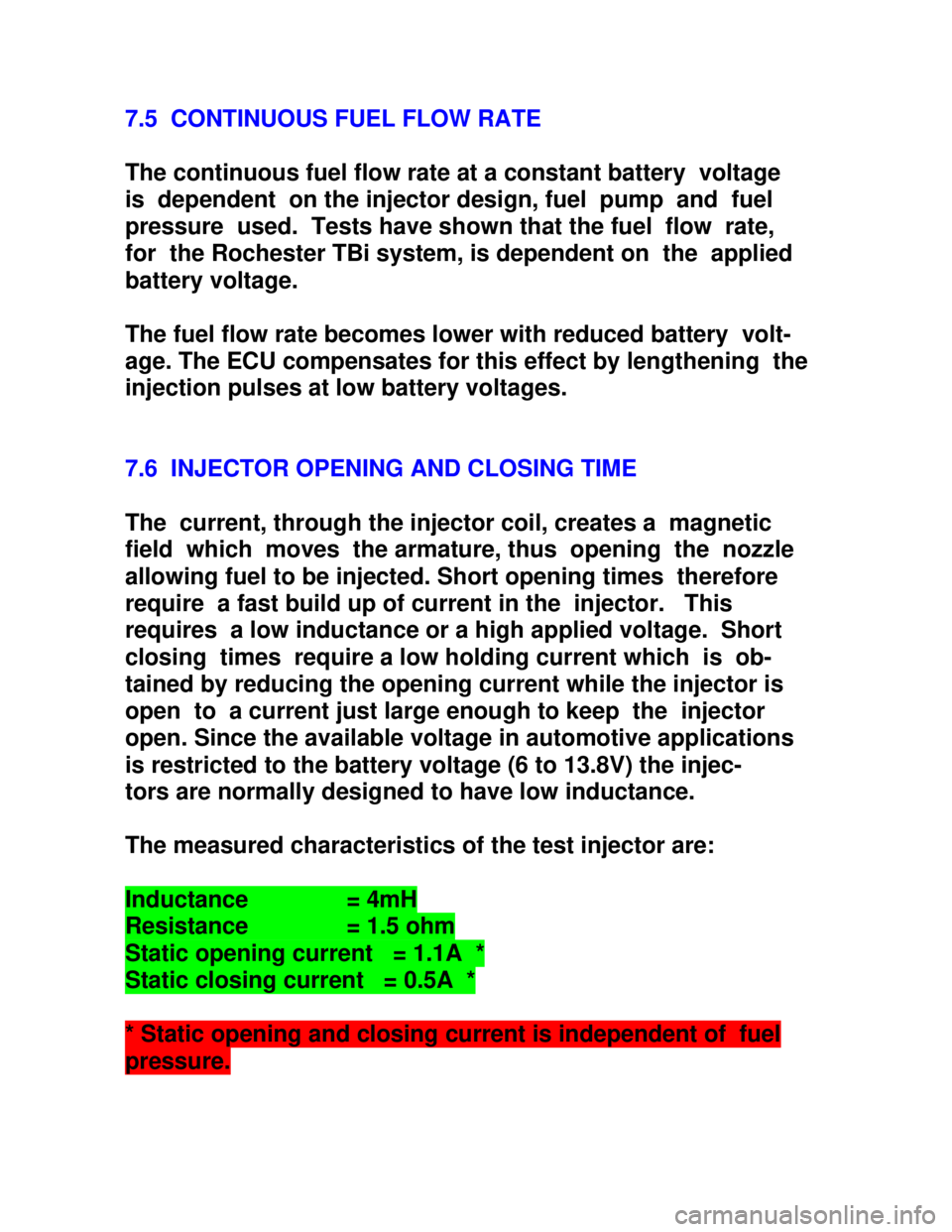
Downloaded from www.Manualslib.com manuals search engine 7.5 CONTINUOUS FUEL FLOW RATE
The continuous fuel flow rate at a constant battery voltage
is dependent on the injector design, fuel pump and fuel
pressure used. Tests have shown that the fuel flow rate,
for the Rochester TBi system, is dependent on the applied
battery voltage.
The fuel flow rate becomes lower with reduced battery volt-
age. The ECU compensates for this effect by lengthening the
injection pulses at low battery voltages.
7.6 INJECTOR OPENING AND CLOSING TIME
The current, through the injector coil, creates a magnetic
field which moves the armature, thus opening the nozzle
allowing fuel to be injected. Short opening times therefore
require a fast build up of current in the injector. This
requires a low inductance or a high applied voltage. Short
closing times require a low holding current which is ob-
tained by reducing the opening current while the injector is
open to a current just large enough to keep the injector
open. Since the available voltage in automotive applications
is restricted to the battery voltage (6 to 13.8V) the injec-
tors are normally designed to have low inductance.
The measured characteristics of the test injector are:Inductance = 4mHResistance = 1.5 ohmStatic opening current = 1.1A *Static closing current = 0.5A ** Static opening and closing current is independent of fuelpressure.
Page 1055 of 1070
Downloaded from www.Manualslib.com manuals search engine The injector drive circuit allows a pull-in current of 4A
and a holding current of 1A. Once an injector current of 4A
is reached the circuit will automatically reduce it to 1A.
Injector opening and closing times vary with battery voltage
and vary between 0.2 ms at 14 volt and 1.35 ms at 6.5 volt.
The ECU takes this into account by measuring the battery
voltage before calculating the injection times.
The electrical opening duration of the injector consists of
the sum of the opening and closing delays and the true
required injection duration.
7.7 INJECTION TIMING
Under static conditions (constant engine load and speed)
fuel will be injected in synchronisation with the crankshaft
position and speed reference signal, i.e. once per intake
stroke. Fuel injection will commence 0.5 ms after the 10ø
BTDC reference.
Page 1059 of 1070
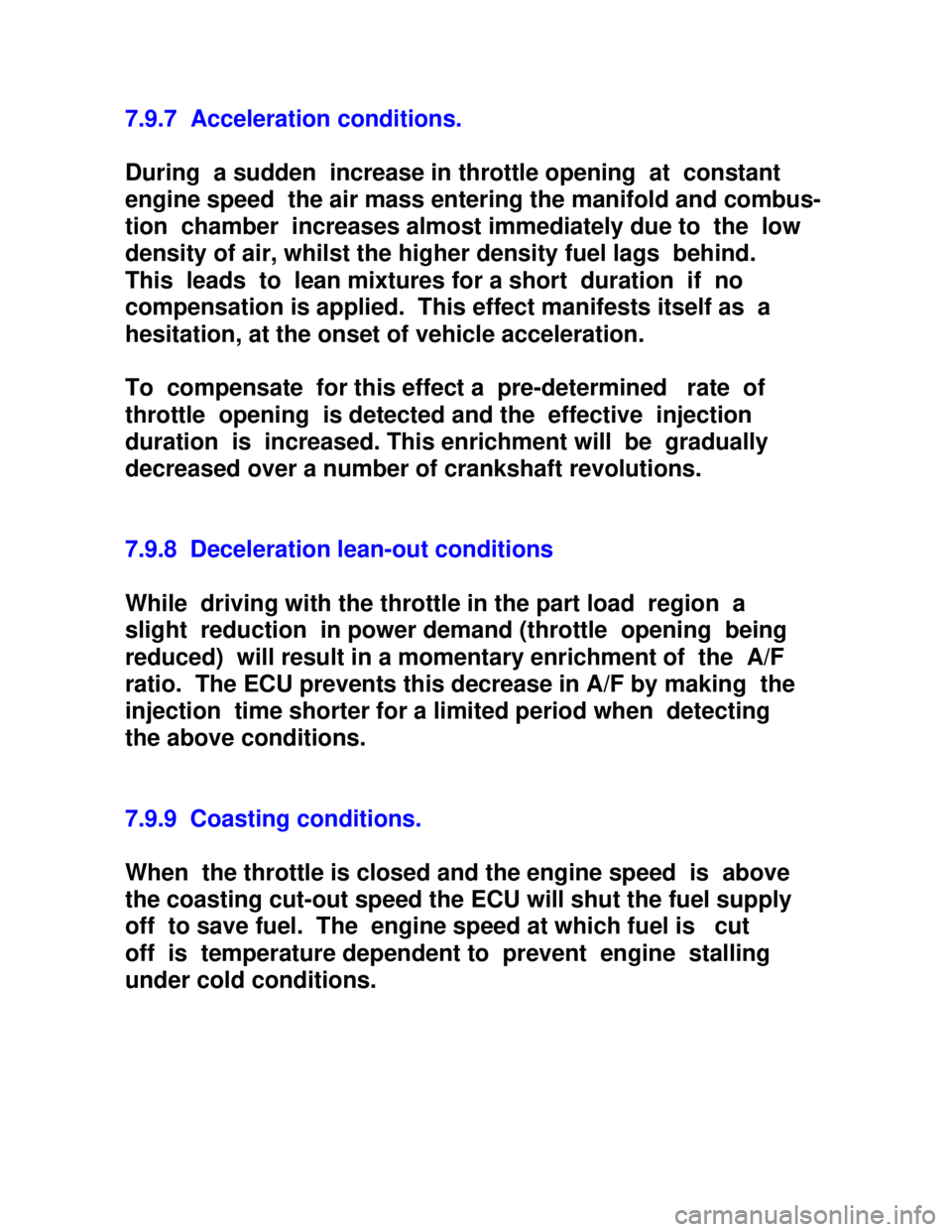
Downloaded from www.Manualslib.com manuals search engine 7.9.7 Acceleration conditions.
During a sudden increase in throttle opening at constant
engine speed the air mass entering the manifold and combus-
tion chamber increases almost immediately due to the low
density of air, whilst the higher density fuel lags behind.
This leads to lean mixtures for a short duration if no
compensation is applied. This effect manifests itself as a
hesitation, at the onset of vehicle acceleration.
To compensate for this effect a pre-determined rate of
throttle opening is detected and the effective injection
duration is increased. This enrichment will be gradually
decreased over a number of crankshaft revolutions.
7.9.8 Deceleration lean-out conditions
While driving with the throttle in the part load region a
slight reduction in power demand (throttle opening being
reduced) will result in a momentary enrichment of the A/F
ratio. The ECU prevents this decrease in A/F by making the
injection time shorter for a limited period when detecting
the above conditions.
7.9.9 Coasting conditions.
When the throttle is closed and the engine speed is above
the coasting cut-out speed the ECU will shut the fuel supply
off to save fuel. The engine speed at which fuel is cut
off is temperature dependent to prevent engine stalling
under cold conditions.